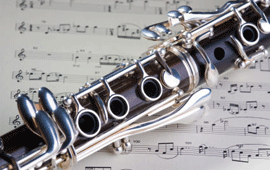> [Archived] Chronicles

'Helsinki-Vienna, back and forth'...
…is the theme of the project initiated by two Romanian composers, who are also sisters: Dana Cristina Probst and Adina Dumitrescu. The two sisters and composers live in Vienna, Austria, respectively in Tampere, Finland; The Finnish clarinetist Mikko Raasakka joined them in organizing the project. It consists of two new music concerts and three composition and clarinet workshops, which took place in Vienna between October 17th and October 20th, 2011. In Helsinki and Tampere, they will take place between October 30th and November 2nd of this year.
The works of fourteen composers are interpreted by flutist Sylvie Lacroix and clarinetist Mikko Raaskka. The project is endorsed by numerous institutions, such as the University of Music and Performing Arts, Vienna, the Vienna Conservatory, the Austrian Embassy in Helsinki, the Austrian Composers Union, Sibelius Academy in Helsinki, the Arts Council of Finland, the Foundation for the Promotion of Finnish Music, the Society for the Promotion of Austrian Music and others.
The clarinet - the main character
I listened to the clarinet recital on Thursday, October 20th at the Alte Schmiede gallery in Vienna (The Old Forge), a recital preceded and followed by works of the two Romanian composers. The work Necklace for bass clarinet by Adina Dumitrescu was the evening opener. It was meant to be a 'necklace offered to the bass clarinet, emphasizing, like a clothing accessory, the instrument's personality' (I quoted the author's words). Personally, I understood it as a stroll of a lightly penciled rhythmic character. Decorative embroideries spring around it, here and there. The clarity and relative simplicity of the leading thread give the piece cohesion and essence. The fluid course is interrupted by exclamations, warnings, perhaps laughter, rhythmic imprecations, and caution. A curious onomatopoeic punctuation is added to the instrumental effects. Here and there, the shouts might have looked absurd, but not in such way as to threaten the balance of the whole.
The pieces Asteletsa by Jukka Tiensuu (1999) and Vers les quatre points by Dana Cristina Probst (2011) have brought out not only the clarinet's multiple sonorities, but also the spatial factor, rapports like <near-far>, <forward, middle, backward, sideways> and others. The clarinetist played in different corners of the room, completing the sonorous suggestion with movement, gestures and steps.
Dana Probst's work was probably the most interesting moment of the evening. The piece is made up of four sections. The clarinetist interprets them from the four 'cardinal' points of the room. The succession leads to the centre, where the circle closes. A few of the attributes I have noticed in passing: pregnant and rich information, economically distributed; expressively well individualized sections; a wide range of 'affections' such as shouting, whispering, interrogations, suspensions; all of this delivered concisely.
The organizing of such project is at the same time proof of the credit Adina Dumitrescu and Dana Cristina Probst have among the listeners and connoisseurs of new music in Austria and Finland.
Translated by Ioana Ristulescu and Alina Popa
MTTLC, Bucharest University














